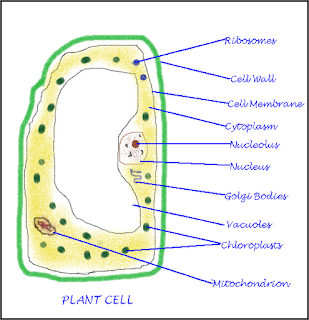Cell Structure and Functions
Questions and Answers based on NCERT Chapter
Q1: Define Cell
Answer: Cell is the basic structural and functional unit of life.
Q2: Who was the first person to see the cell?
Answer: Robert Hooke, who was the first person to see the cell, in 1665 observed slices of cork under a simple magnifying device.
Q3: What is cork made up of?
Answer: It is a part of the bark of a tree and is made of dead cells.
Q4: Can we see cells with unaided eye?
Answer: Usually animal and plant cells are so small that these can't be seen by the unaided eye. We need a microscope to observe cells. There are few exceptions like hen's egg cell or ostrich's egg which is made up of one large cell that can be seen by an unaided eye.
Q5: Name the largest cell.
Answer: Ostrich's egg.
Q6: What does "cellula" mean in Latin?
Answer: It means a small chamber.
Q7: Name the scientist who discovered nucleus of the cell?
Answer: Robert Brown
Q8: What do we call the single-celled organism?
Answer: Unicellular
Q9: Give two examples of single-celled organisms.
Answer: Amoeba, Paramecium
Q10: Give two examples of cells which do not have a definite shape.
Answer: Amoeba and WBC (White Blood Cell) in human blood.
Q11: Which part of the egg is the cell?
Answer: Yellow portion called yolk.
Q12: Why do cells of human body differ in size and shape? Give an example.
Answer: Shapes and sizes of cells are related to their specific functions. For example, a nerve cell is elongated and branched so that it can transmit neuro messages between the brain and other parts of the body.
Q13: What is the shape of red blood cells of humans?
Answer: Spherical
Q14: What is the shape of muscle cells in humans?
Answer: Spindle shaped
Q15: How does a unicellular organism function? How it is different in multi-cellular organisms?
Answer: The single cell of the unicellular organism performs all the necessary functions like digestion, respiration, excretion, reproduction etc. In multi-cellular organisms, these activities are performed by specialized cells called tissues.
Q16: What is the relation between cell, tissue and organ?
Answer: Specialized like cells combine to form tissues. Tissues combine together to form an organ which performs specific functions.
Q17: What is called "false feet" in amoeba?
Answer: Projections in amoeba are called pseudopodia.
Q18: What do we call the outer covering of an animal cell?
Answer: Plasma or Cell Membrane
Q19: What do we call the outer covering of a plant cell?
Answer: Cell wall.
Q20: What is the purpose of cell wall?
Answer: It gives shape and rigidity to plant cell. It also protects against variations in temperature, high wind speed, atmospheric moisture, etc.
Q21: Which is the smallest cell?
Answer: Mycoplasm bacteria (unicellular). Its size is 0.1 to 0.5 micrometre.
Q22: What is the purpose of methylene blue solution while preparing onion peel slide?
Answer: It is used in microscopy to stain cells of onion so that these cells (and cell parts) are distinctly visible under a microscope.
Q23: Name the three main parts of a cell.
Answer: The cell has three main parts i.e.
(i) the cell membrane,
(ii) cytoplasm which contains smaller components called organelles, and
(iii) the nucleus.
Q24: Identify the jelly like substance which fills the most of the cell.
Answer: Cytoplasm
Q25: What is called the living substance of a cell?
Answer: Protoplasm. It consists of cytoplasm and nucleus.
Q26: Name any two organelles found in the cytoplasm.
Answer: Mitochondria, Golgi bodies, Ribosomes, etc.
Q27: Which layer separates the nucleus from cytoplasm?
Answer: nuclear membrane
Q28: Which cell organelle is called the control centre?
Answer: Nucleus
Q29: What is a gene?
Answer: Gene is a unit of inheritance in living organisms. It is present on chromosomes inside the nucleus of the cell. It controls the transfer of a hereditary characteristic from parents to offspring.
Q30: What are prokaryotes?
Answer: Those organisms who do not have well-defined nucleus i.e. nuclear material without membrane are called prokaryotes.
Q31: Give two examples of prokaryotes.
Answer: bacteria and blue green algae
Q32: What are eukaryotes?
Answer: Organisms whose cells have well-defined nucleus along with nuclear membrane are called eukaryotes.
Q33: Which cell (animal and plant) has smaller sized vacuole?
Answer: Animal cell
Q34: What are the functions of chloroplasts?
Answer: Chloroplasts are green coloured plastids in plant cells. They give a green colour to plant leaves. They contain chlorophyll which carries out photosynthesis.
Q35: In which phase chromosomes are visible in a cell?
Answer: When cells are dividing.
Q36: An elephant is much bigger than a rat. Does that mean an elephant's cell will be larger than a cell of a rat?
Answer: No. Because the size of the cell does not depend on the size of the body of the animal or plant.



very useful
ReplyDeletethese answers are sooo useful
DeleteVery good answers.
ReplyDeleteThis comment has been removed by the author.
ReplyDeletereal use for exams
ReplyDeletei like these answers
ReplyDeleteIn question 17 it is pseudopodia and it is written pseudopodia
ReplyDeleteCorrected it. Thanks
Deletemmm..
ReplyDelete